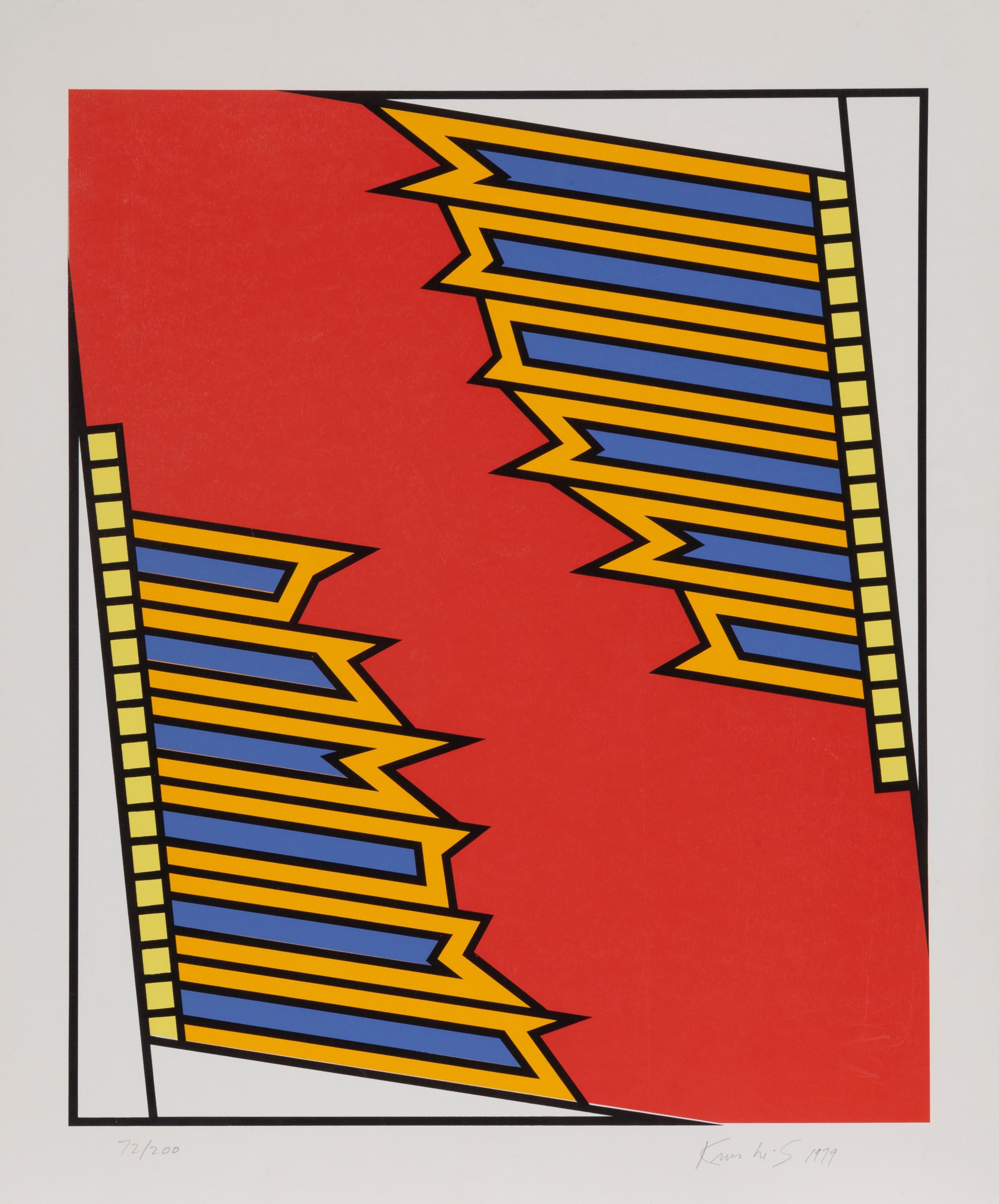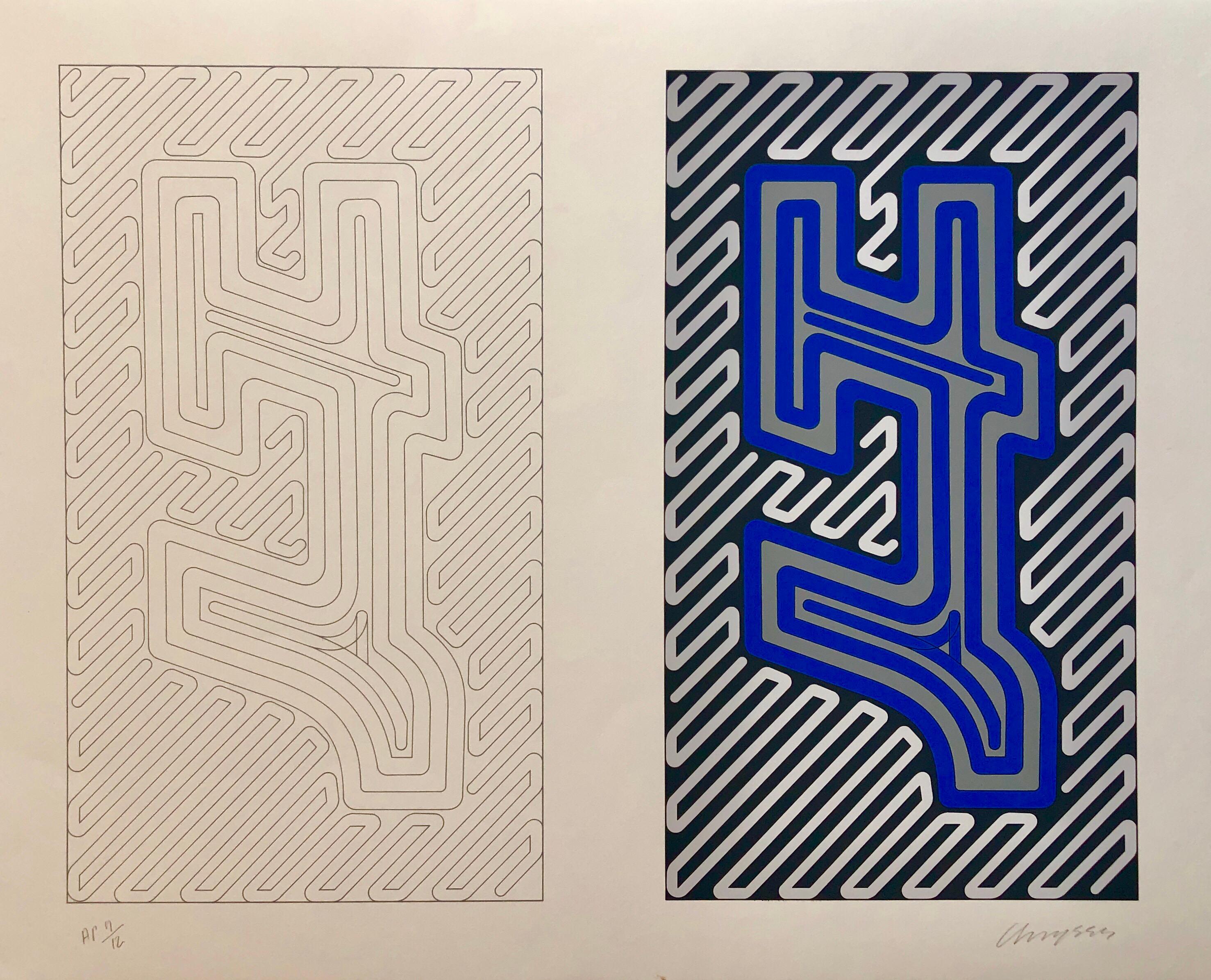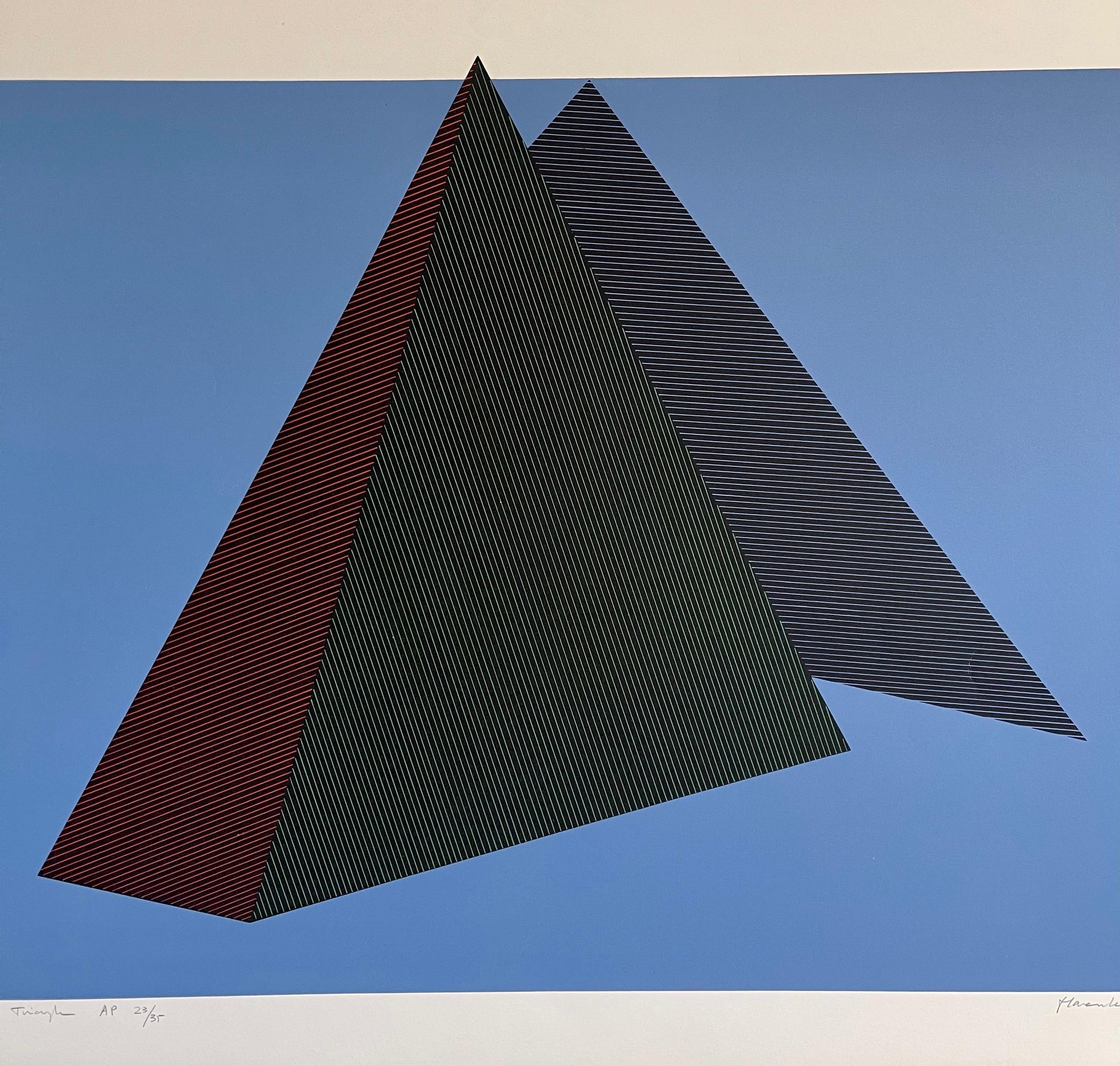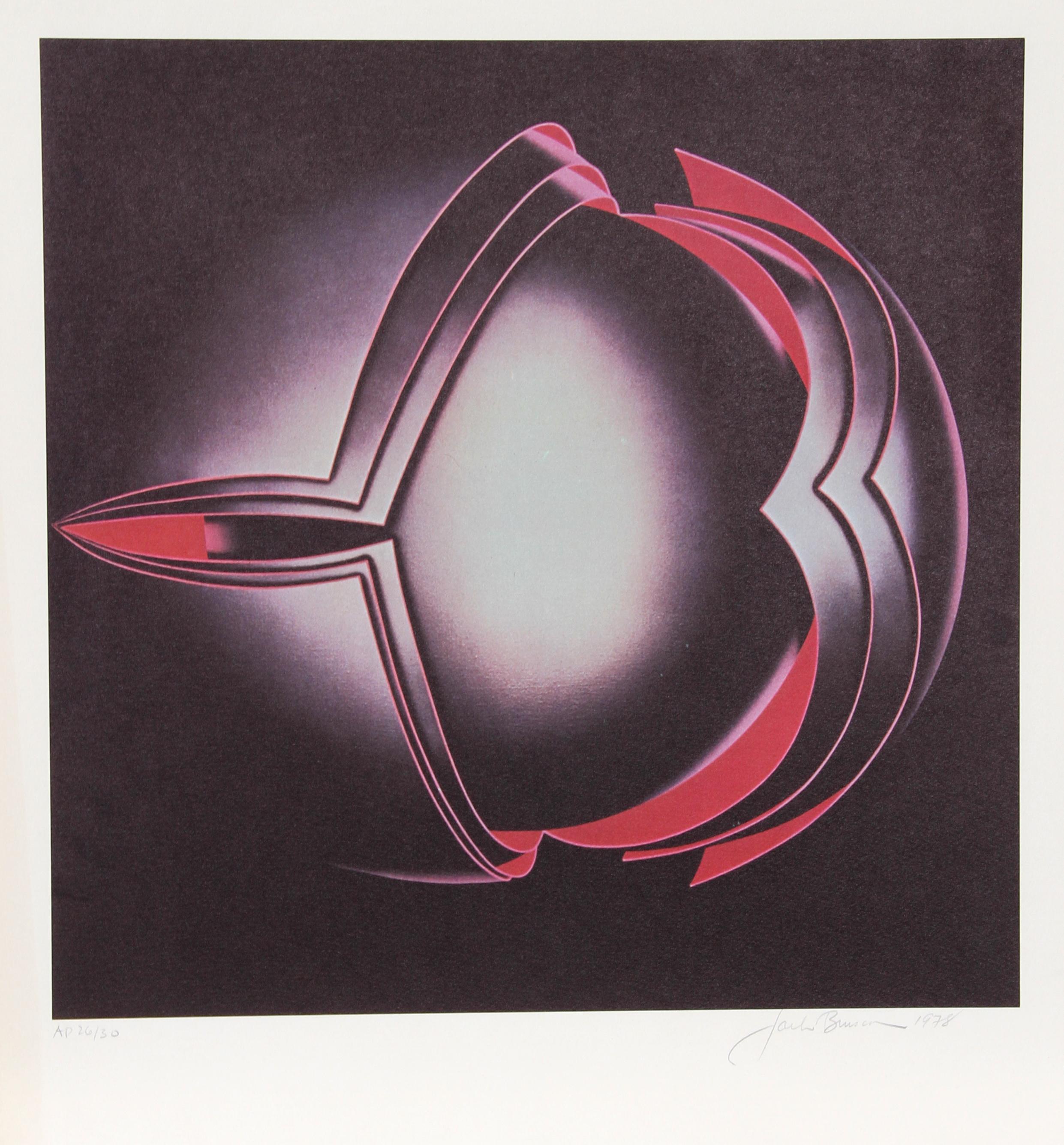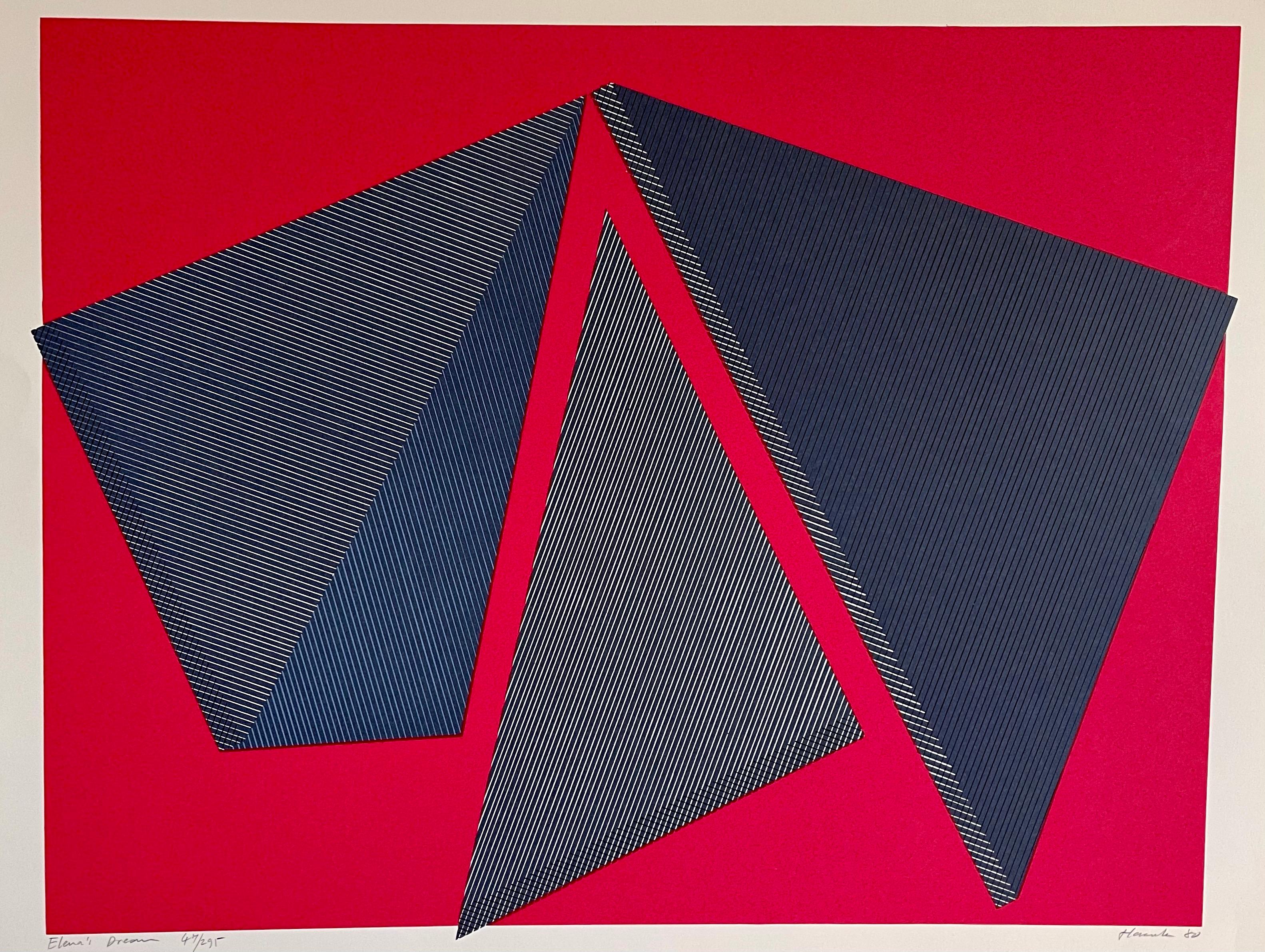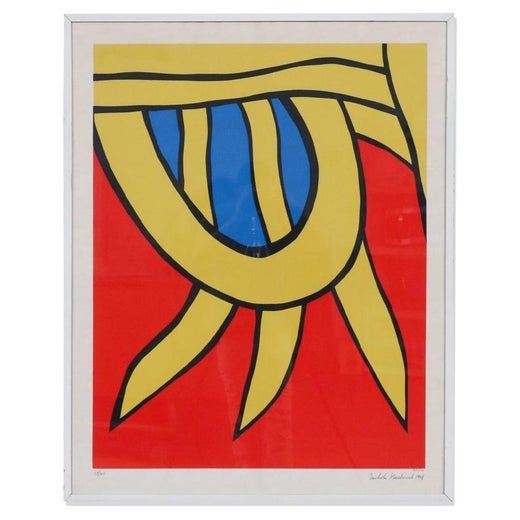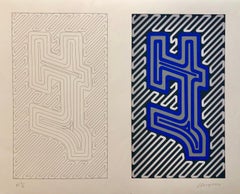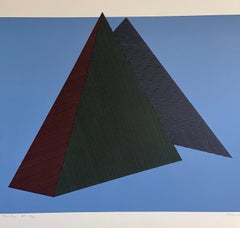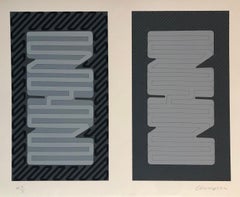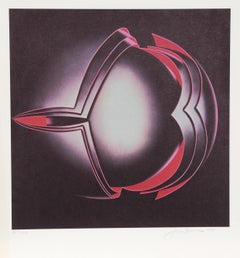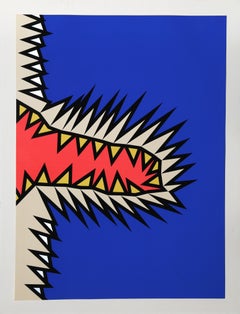Items Similar to 1980 Large Pop Art Silkscreen Abstract Op Art Jagged Edge Bright Color Serigraph
Want more images or videos?
Request additional images or videos from the seller
1 of 11
Nicholas Krushenick1980 Large Pop Art Silkscreen Abstract Op Art Jagged Edge Bright Color Serigraph1980
1980
$1,200
£932.69
€1,056.06
CA$1,714.57
A$1,866.76
CHF 977.41
MX$22,407.36
NOK 12,335.53
SEK 11,566.66
DKK 7,886.27
About the Item
Green, Red, Silver and Black and White. Large Pop Art Silkscreen.
Nicholas Krushenick (May 31, 1929 – February 5, 1999) was an American abstract painter whose artistic style straddled the line between Op Art, Pop Art, Abstract Expressionism, Minimalism and Color Field. He was active in the New York art scene in the 1960s and 1970s, before he withdrew and focused his time as a professor at the University of Maryland for almost thirty years until his death in 1999. Initially experimenting with a more Abstract Expressionist inspired style and cut paper collage, Krushenick is more well known for his paintings which use bold Liquitex colors and juxtaposing black lines, which fall under the category of pop abstraction. In fact, he is a singular figure within that style.
Born in New York City in 1929, Krushenick dropped out of high school, served in World War II, worked on constructing the Major Deegan Expressway, and then returned to art school, with the help of the GI Bill. He attended the Art Students League of New York (1948–1950) and the Hans Hofmann School of Fine Art (1950–1951). In the early 1950s Krushenick supported himself and his family by designing window displays for department stores and working for the Whitney and Metropolitan museums and the Museum of Modern Art. In 1957, he and his brother, John Krushenick, opened a framing shop on Tenth Street, which quickly turned into an artists' cooperative called Brata Gallery. Artists such as Al Held, Ronald Bladen, Ed Clark, Yayoi Kusama, and George Sugarman exhibited there. In 1962, Krushenick left the gallery and began receiving solo-exhibitions around the world. In the 1960s and 1970s, he was a prominent painter in the New York art scene. However, in his later years, Krushenick taught at the University of Maryland, College Park from 1977 to 1991. He died in New York on February 5, 1999, at age 69.
Krushenick was part of a generation emerging at a time when Abstract Expressionism had fallen out of fashion; these artists were trying to distance themselves from this style and create something new. As a result, Krushenick's work in particular straddled the lines of many styles, including: Op Art, Pop Art, Abstract Expressionism, Minimalism, and Color Field. Some of his inspirations were Henri Matisse, J. M. W. Turner, Henri Rousseau, Fernand Leger, Alexander Calder, Roy Lichtenstein, and Claes Oldenburg. The last two, in particular, Krushenick considered the fathers of pop. In 1956, Nicholas Krushenick debuted alongside his brother at Camino Gallery. At this stage, Krushenick's paintings resembled the Abstract Expressionist style considerably, yet already he was starting to poise masses next to each other in something of a "Cubist persuasion."
Select Solo Exhibitions
1957 Nicholas Krushenick, Camino Gallery, New York, January 25–February 15
1958 Nicholas Krushenick, Brata Gallery, New York, October 24–November 12
1962 Nicholas Krushenick, Graham Gallery, New York, September 18–October 6
1965 Nicholas Krushenick, Fischbach Gallery, New York, April 6–24
1966 Nicholas Krushenick, Galerie Müller, Stuttgart, May 7–June 30
1967 Galerie Nächst St. Stephan, Vienna
Nicholas Krushenick, Galerie Sonnabend, Paris, January
Nicholas Krushenick: Paintings, Pace Gallery, New York, March 18–April 15
1968 Nicholas Krushenick, Walker Art Center, Minneapolis, January 24–February 25
Nicholas Krushenick, Galerie Renée Ziegler, Zürich, October 19–November 11
1971 Nicholas Krushenick, Galerie Beyeler, Basel, May–June 15
1972 Nicholas Krushenick: New Painting and Collage, Pace Gallery, New York, January 8–February
1973 Galerie Denise Rene: Hans Mayer, Düsseldorf
1999 Nicholas Krushenick: New and Early Paintings, Mitchell Algus Gallery,
Nicholas Krushenick: Pop-Abstract Painter, Loyola Hall, Fairfield University, Fairfield, Connecticut,
2001 Nicholas Krushenick: Paintings of the 1980s, Mitchell Algus Gallery, New York, February 10–
2007 Nicholas Krushenick, Marianne Boesky Gallery, New York, May 4–June 16
2008 Nicholas Krushenick, Galerie Renée Ziegler, Zürich, August 31–October 31
2014 Nicholas Krushenick: Early Paintings, Garth Greenan Gallery, New York
2015 Nicholas Krushenick: Electric Soup, Frances Young Tang Teaching Museum and Art Gallery, Skidmore College
Select Group Exhibitions
1963 New Experiments in Art, DeCordova Museum, Lincoln, Massachusetts, March 23–April 28
1963–1964 Annual Exhibition 1963: Contemporary American Painting, Whitney Museum of American Art.
Post Painterly Abstraction, Los Angeles County Museum of Art, April 23–June 7; Walker Art Center, Minneapolis, July 13–August 16; Art Gallery of Toronto, November 20–December 20
1965 The Twenty-ninth Biennial Exhibition of Contemporary American Painting, Corcoran Gallery of Art, Washington, D.C., February 26–April 18
1965–1966 1965 Annual Exhibition of Contemporary American Painting, Whitney Museum of American Art, New York, December 8, 1965–January 30, 1966
1966 Contemporary Art USA, Norfolk Museum of Arts and Sciences, Norfolk, Virginia
Systemic Painting, Solomon R. Guggenheim Museum, New York, September–November
Musische Geometrie im Kunstverein Hannover, Kunstverein Hannover, Hannover, Germany,
1966–1967 Vormen van de Kleur, Stedelijk Museum, Amsterdam,
1967 The 5th International Biennial Exhibition of Prints in Tokyo, National Museum of Modern Art, Tokyo, December 4, 1966–January 22, 1967; National Museum of Modern Art, Kyoto
1968 Documenta IV, Fridericianum, Kassel, Germany, June 27–October 6
Art of the ’60s: Selections from Collection of Hanford Yang, Aldrich Museum of Contemporary Art,
Untitled, 1968, San Francisco Museum of Art, November 11–December 29
1969 Tamarind: Homage to Lithography, Museum of Modern Art, New York, April 29–June 30
The Spirit of the Comics, Institute of Contemporary Art, University of Pennsylvania, Philadelphia,
1973 Homage à Picasso, Kestner-Gesellschaft, Hannover, Germany,
1976 Tenth Street Days: The Co-ops of the 50’s, Amos Eno Gallery, New York,
1980 Art & Dance: Images of the Modern Dialogue, 1890–1980, Institute of Contemporary Art,
Select Collections
Albright-Knox Art Gallery, Buffalo
Chrysler Museum of Art, Norfolk, Virginia
Cleveland Museum of Art
Cranbrook Art Museum, Bloomfield Hills, Michigan
Dallas Museum of Art
Galerie der Stadt, Stuttgart
Governor Nelson A. Rockefeller Empire State Plaza Art Collection, Albany, NY
Guild Hall Museum, East Hampton, New York
Herbert F. Johnson Museum of Art, Cornell University, Ithaca, New York
Hirshhorn Museum and Sculpture Garden, Smithsonian Institution, Washington, D.C.
Los Angeles County Museum of Art
Metropolitan Museum of Art, New York
Museum of Contemporary Art Australia, Sydney
Museum of Modern Art, New York
Neuberger Museum of Art, Purchase College, State University of New York
San Francisco Museum of Modern Art
Smithsonian American Art Museum, Washington, D.C.
Stamford Museum & Nature Center, Stamford, Connecticut
Stedelijk Museum, Amsterdam
Walker Art Center, Minneapolis
Weatherspoon Art Museum, University of North Carolina, Greensboro
Whitney Museum of American Art, New York
Yale University Art Gallery, New Haven, Connecticut
- Creator:Nicholas Krushenick (1929-1999, American)
- Creation Year:1980
- Dimensions:Height: 31 in (78.74 cm)Width: 40 in (101.6 cm)
- Medium:
- Movement & Style:
- Period:
- Condition:good. minor wear, minor creasing to edges, please see photos.
- Gallery Location:Surfside, FL
- Reference Number:1stDibs: LU38215538852
Nicholas Krushenick
orn in the Bronx, New York in 1929, Nicholas Krushenick studied painting at the Art Students League of New York and the Hans Hofmann School of Fine Arts. After completing his training, Krushenick designed window displays and worked in the Framing Department of the Museum of Modern Art. From 1957 to 1962, the artist, along with his brother John, operated the now legendary Brata Gallery in Manhattan’s East Village. Brata displayed the works of many of the foremost artists of the day, including, among others: Ronald Bladen, Ed Clarke, Al Held, Yayoi Kusama, and George Sugarman. Krushenick first developed his signature “pop abstract” style in the early 1960s. The loose geometries and web-like forms of his early paintings demonstrate his deliberate caricature of Abstract Expressionist “drips” or “skeins” into what more closely resemble details from cartoons—like Superman’s hair follicles, as critic Robert Rosenblum once described. The high-keyed color, formal rigor, and sheer graphic intensity of his paintings set Krushenick apart from his contemporaries. As a result, decades after its creation, Krushenick’s work still appears remarkably fresh. During the 1960s and 1970s, Krushenick had solo exhibitions at many of the most influential and prestigious galleries, including: Graham Gallery (1958, 1962, 1964, New York), Fischbach Gallery (1965, New York), Galerie Sonnabend (1967, Paris), Galerie Ziegler (1969, Zürich), Galerie Beyeler (1971, Basel), and Pace Gallery (1967, 1969, 1972, New York). During this period, his work also figured prominently in many landmark museum exhibitions, such as Post Painterly Abstraction (1964, Los Angeles County Museum of Art), Vormen van de Kleur (1964, Stedelijk Museum), Systemic Painting (1965, Solomon R. Guggenheim Museum), and Documenta 4 (1968, Fredericianum), among others. In 1968, the Walker Art Center mounted a retrospective exhibition of Krushenick’s work. His first European retrospective came four years later, in 1972, at the Kestner-Gesellschaft in Hannover, Germany. In 2015 he had a retrospective at the Tang Gallery, Skidmore College, Saratoga Springs, New York entitled Nicholas Krushenick: Electric Soup. Krushenick’s work is featured in the collections of over sixty major museums, including: the Albright-Knox Art Gallery; the Baltimore Museum of Art; the Cleveland Museum of Art; the Dallas Museum of Fine Art; the Empire State Art Collection; the Grey Art Gallery, New York University; the Los Angeles County Museum of Art; the Metropolitan Museum of Art; the Museum of Modern Art; San Francisco Museum of Modern Art; the Smithsonian American Art Museum, Washington, D.C.; the Stedelijk Museum; the Virginia Museum of Fine Arts, Richmond; the Walker Art Center, Minneapolis; and the Whitney Museum of American Art.
About the Seller
4.9
Platinum Seller
Premium sellers with a 4.7+ rating and 24-hour response times
Established in 1995
1stDibs seller since 2014
1,831 sales on 1stDibs
Typical response time: 1 hour
- ShippingRetrieving quote...Shipping from: Surfside, FL
- Return Policy
More From This Seller
View All1970's Large Silkscreen Abstract Geometric Day Glo Serigraph Pop Art Print Neon
By Chryssa Vardea-Mavromichali
Located in Surfside, FL
Silkscreen on Arches paper, Hand signed and Numbered in Pencil. Serigraph in white, back, blue gray (silver).
Chryssa Vardea-Mavromichali (Greek: Χρύσα Βαρδέα-Μαυρομιχάλη; December 31, 1933 – December 23, 2013) was a Greek American artist who worked in a wide variety of media. An American art pioneer in light art and luminist sculpture widely known for her neon, steel, aluminum and acrylic glass installations, she has always used the mononym Chryssa professionally. She worked from the mid-1950s in New York City studios and worked since 1992 in the studio she established in Neos Kosmos, Athens, Greece.
Chryssa was born in Athens into the famous Mavromichalis family from the Mani Peninsula. one of her sisters, who studied medicine, was a friend of the poet and novelist Nikos Kazantzakis.
Chryssa began painting during her teenage years and also studied to be a social worker.In 1953, on the advice of a Greek art critic, her family sent her to Paris to study at the Académie de la Grande Chaumiere where Andre Breton, Edgard Varese, and Max Ernst were among her associates and Alberto Giacometti was a visiting professor.
In 1954, at age twenty-one, Chryssa sailed for the United States, arrived in New York and went to San Francisco, California to study at the California School of Fine Arts. Returning to New York in 1955, she became a United States citizen and established a studio in the city.
Chryssa's first major work was The Cycladic Books preceded American minimalism by seventeen years.
1961, Chryssa's first solo exhibition was mounted at The Guggenheim.
1963, Chryssa's work was shown at the Museum of Modern Art in curator Dorothy Canning Miller's Americans 1963 exhibition. The artists represented in the show also included Richard Anuszkiewicz, Lee Bontecou, Robert Indiana, Richard Lindner, Marisol, Claes Oldenburg, Ad Reinhardt, James Rosenquist and others.
1966, The Gates to Times Square, regarded as "one of the most important American sculptures of all time" and "a thrilling homage to the living American culture of advertising and mass communications." The work is a 10 ft cube installation of two huge letter 'A's through which visitors may walk into "a gleaming block of stainless steel and Plexiglas that seems to quiver in the play of pale blue neon light" which is controlled by programmed timers. First shown in Manhattan's Pace Gallery, it was given to the Albright-Knox Art Gallery in Buffalo, New York in 1972.
1972, The Whitney Museum of American Art mounted a solo exhibition of works by Chryssa.
That's All (early 1970s), the central panel of a triptych related to The Gates of Times Square, was acquired by the Museum of Modern Art between 1975 and 1979.
1973, Chryssa's solo exhibition at the Gallerie Denise René was reviewed for TIME magazine by art critic Robert Hughes before it went on to the Galleries Denise René in Düsseldorf and Paris.
Other works by Chryssa in composite honeycomb aluminum and neon in the 1980s and 1990s include Chinatown, Siren, Urban Traffic, and Flapping Birds.
Chryssa 60/90 retrospective exhibition in Athens in the Mihalarias Art Center. After her long absence from Greece, a major exhibition including large aluminum sculptures - cityscapes, "neon boxes" from the Gates to the Times Square, paintings, drawings etc. was held in Athens.
In 1992, after closing her SoHo studio, which art dealer Leo Castelli had described as "one of the loveliest in the world," Chryssa returned to Greece. She found a derelict cinema which had become a storeroom stacked with abandoned school desks and chairs, behind the old Fix Brewery near the city center in Neos Kosmos, Athens. Using the desks to construct enormous benches, she converted the space into a studio for working on designs and aluminum composite honeycomb sculptures...
Category
1980s Pop Art Abstract Prints
Materials
Screen
Jean Marie Haessle Abstract Geometric Op Art Silkscreen Lithograph Print
By Jean-Marie Haessle
Located in Surfside, FL
Jean Marie Haessle, French-American (1939-)
Serigraph silkscreen
Hand signed in pencil and numbered
Bermuda Triangle (Blue background)
1980
Jean Marie Haessle was born in 1939 in ...
Category
1980s Abstract Geometric Abstract Prints
Materials
Lithograph, Screen
Jean Marie Haessle Abstract Geometric Op Art Silkscreen Lithograph Print
By Jean-Marie Haessle
Located in Surfside, FL
Jean Marie Haessle, French-American (1939-)
Serigraph silkscreen
Hand signed in pencil and numbered
Elana's Dream (red background)
1980
Jean Marie Haessle was born in 1939 in Alsa...
Category
1980s Abstract Geometric Abstract Prints
Materials
Lithograph, Screen
1970's Large Silkscreen Abstract Geometric Day Glo Serigraph Pop Art Print Neon
By Chryssa Vardea-Mavromichali
Located in Surfside, FL
Silkscreen on Arches paper, Hand signed and Numbered in Pencil. Serigraph in black, gray (silver).
Chryssa Vardea-Mavromichali (Greek: Χρύσα Βαρδέα-Μαυρομιχάλη; December 31, 1933 – December 23, 2013) was a Greek American artist who worked in a wide variety of media. An American art pioneer in light art and luminist sculpture widely known for her neon, steel, aluminum and acrylic glass installations, she has always used the mononym Chryssa professionally. She worked from the mid-1950s in New York City studios and worked since 1992 in the studio she established in Neos Kosmos, Athens, Greece.
Chryssa was born in Athens into the famous Mavromichalis family from the Mani Peninsula. one of her sisters, who studied medicine, was a friend of the poet and novelist Nikos Kazantzakis.
Chryssa began painting during her teenage years and also studied to be a social worker.In 1953, on the advice of a Greek art critic, her family sent her to Paris to study at the Académie de la Grande Chaumiere where Andre Breton, Edgard Varese, and Max Ernst were among her associates and Alberto Giacometti was a visiting professor.
In 1954, at age twenty-one, Chryssa sailed for the United States, arrived in New York and went to San Francisco, California to study at the California School of Fine Arts. Returning to New York in 1955, she became a United States citizen and established a studio in the city.
Chryssa's first major work was The Cycladic Books preceded American minimalism by seventeen years.
1961, Chryssa's first solo exhibition was mounted at The Guggenheim.
1963, Chryssa's work was shown at the Museum of Modern Art in curator Dorothy Canning Miller's Americans 1963 exhibition. The artists represented in the show also included Richard Anuszkiewicz, Lee Bontecou, Robert Indiana, Richard Lindner, Marisol, Claes Oldenburg, Ad Reinhardt, James Rosenquist and others.
1966, The Gates to Times Square, regarded as "one of the most important American sculptures of all time" and "a thrilling homage to the living American culture of advertising and mass communications." The work is a 10 ft cube installation of two huge letter 'A's through which visitors may walk into "a gleaming block of stainless steel and Plexiglas that seems to quiver in the play of pale blue neon light" which is controlled by programmed timers. First shown in Manhattan's Pace Gallery, it was given to the Albright-Knox Art Gallery in Buffalo, New York in 1972.
1972, The Whitney Museum of American Art mounted a solo exhibition of works by Chryssa.
That's All (early 1970s), the central panel of a triptych related to The Gates of Times Square, was acquired by the Museum of Modern Art between 1975 and 1979.
1973, Chryssa's solo exhibition at the Gallerie Denise René was reviewed for TIME magazine by art critic Robert Hughes before it went on to the Galleries Denise René in Düsseldorf and Paris.
Other works by Chryssa in composite honeycomb aluminum and neon in the 1980s and 1990s include Chinatown, Siren, Urban Traffic, and Flapping Birds.
Chryssa 60/90 retrospective exhibition in Athens in the Mihalarias Art Center. After her long absence from Greece, a major exhibition including large aluminum sculptures - cityscapes, "neon boxes" from the Gates to the Times Square, paintings, drawings etc. was held in Athens.
In 1992, after closing her SoHo studio, which art dealer Leo Castelli had described as "one of the loveliest in the world," Chryssa returned to Greece. She found a derelict cinema which had become a storeroom stacked with abandoned school desks and chairs, behind the old Fix Brewery near the city center in Neos Kosmos, Athens. Using the desks to construct enormous benches, she converted the space into a studio for working on designs and aluminum composite honeycomb sculptures...
Category
1980s Pop Art Abstract Prints
Materials
Screen
Surrealist Abstract Hebrew Aleph Pop Art Silkscreen Judaica Jewish Serigraph
By Jozsef Jakovits
Located in Surfside, FL
Abstract Hebrew Prints on heavy mould made paper from small edition of 15. there is a facing page of text in Hungarian folded over. Hard edged geometric abstract prints in color base...
Category
1980s Pop Art Abstract Prints
Materials
Archival Paper, Screen
Abstract Geometric 1970s Kinetic Silkscreen Screen Print Manner Vasarely Op Art
By Paul M. Levy
Located in Surfside, FL
Paul Levy (American, b. 1944) An established designer and illustrator, Paul M. Levy was born in Brooklyn, New York, in 1944. He received his B.S. in Industrial Design from the Univer...
Category
1970s Abstract Geometric Abstract Prints
Materials
Screen
You May Also Like
Silver Liner, Pop Art Abstract Geometric Screenprint by Nicholas Krushenick
By Nicholas Krushenick
Located in Long Island City, NY
Artist: Nicholas Krushenick, American (1929 - 1999)
Title: Silver Liner
Year: 1978
Medium: Screenprint, signed and numbered in pencil
Edition: 200; AP 30
Size: 32 x 26 inches (66.0...
Category
1970s Pop Art Abstract Prints
Materials
Screen
Kindergarten, Pop Geometric Abstract Silkscreen by Krushenick
By Nicholas Krushenick
Located in Long Island City, NY
Artist: Nicholas Krushenick, American (1929 - 1999)
Title: Kindergarten
Year: 1979
Medium: Silkscreen, signed and numbered in pencil
Edition: 200, AP 35
Image Size: 33.5 x 24 inche...
Category
1970s Pop Art Abstract Prints
Materials
Screen
Diaz II, Op Art Screenprint by Jack Brusca
By Jack Brusca
Located in Long Island City, NY
Artist: Jack Brusca, American (1939 - 1993)
Title: Diaz II
Year: 1978
Medium: Screenprint, signed and numbered in pencil
Edition: 200, AP 30
Image Size: 18 x 18 inches
Size: 22 in. x...
Category
1970s Pop Art Abstract Prints
Materials
Screen
Untitled VI, Geometric Pop Art Screenprint by Nicholas Krushenick
By Nicholas Krushenick
Located in Long Island City, NY
Artist: Nicholas Krushenick, American (1929 - 1999)
Title: Untitled VI from Fire-Flash-Fire-Fade Portfolio
Year: 1971
Medium: Screenprint, signed and numbered in pencil
Edition: 150
...
Category
1970s Pop Art Abstract Prints
Materials
Screen
North End, Nicholas Krushenick
By Nicholas Krushenick
Located in Fairfield, CT
Artist: Nicholas Krushenick (1929-1999)
Title: North End
Year: 1979
Edition: 15/200, plus proofs
Medium: Silkscreen on wove paper
Size: 36 x 26 inches
Condition: Good
Inscription: Signed and numbered by the artist.
NICHOLAS KRUSHENICK (1929-1999) One of America’s premier Pop artists, Nicholas Krushenick’s work consists of geometric abstract motifs whose shapes were outlined in heavy black lines. In this regard his original prints were often compared to those of Pop Art co-horts Roy Lichtenstein and Andy Warhol, but unlike these masters Krushenick avoided any imagery from commercial art...
Category
1970s Pop Art Abstract Prints
Materials
Screen
$876 Sale Price
20% Off
Untitled I, Abstract Geometric Screenprint by Yves Millecamps
By Yves Millecamps
Located in Long Island City, NY
Artist: Yves Millecamps, French (1930 - )
Title: Untitled I
Year: Circa 1979
Medium: Screenprint, signed and numbered in pencil
Edition: AP
Paper Size: 30.5 x 30.5 in. (77.47 x ...
Category
1970s Pop Art Abstract Prints
Materials
Screen
